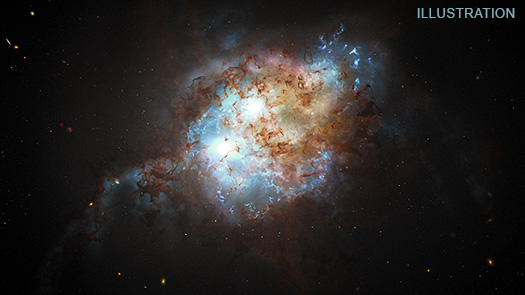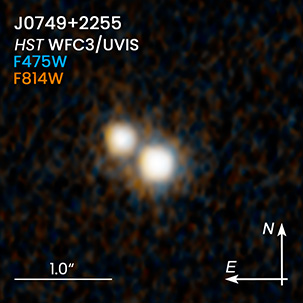A Pair of Merging Galaxies Ignite Black Holes on a Collision Course

Artist's Illustration of Dual Quasar J0749+2255
Artwork Credit: NASA, ESA, Joseph Olmsted (STScI) Science Credit: NASA, ESA, Yu-Ching Chen (UIUC), Hsiang-Chih Hwang (IAS), Nadia Zakamska (JHU), Yue Shen (UIUC)
Quasars are among the universe's brightest fireworks. Scattered all across the sky, they blaze with the opulence of over 100 billion stars. And, like a brilliant July 4th aerial flare, they are dazzling for a relatively brief time — on cosmic timescales. That's because they're powered by voracious supermassive black holes gobbling up a lot of gas and dust that gets heated to high temperatures. But the quasar food buffet lasts only so long.
This fleeting characteristic of quasars helped astronomers find two quasars on a collision course with each other. They are embedded inside a pair of galaxies that smashed into each other 10 billion years ago. It's rare to find such a dynamic duo in the far universe. The detection yields clues as to how unsettled the cosmos was long ago, when galaxies more frequently collided and black holes were engorged with flotsam and jetsam from the close encounters.
Because the two quasars flicker at different rates as their inflow of fuel waxes and wanes, they were identified as an unusual activity happening out in space. Hubble zoomed in and clearly resolved the pair, as well as their host galaxies.
The early universe was a rambunctious place where galaxies often bumped into each other and even merged together. Using NASA's Hubble Space Telescope and other space and ground-based observatories, astronomers investigating these developments have made an unexpected and rare discovery: a pair of gravitationally bound quasars, both blazing away inside two merging galaxies. They existed when the universe was just 3 billion years old.
Quasars are bright objects powered by voracious, supermassive black holes blasting out ferocious fountains of energy as they engorge themselves on gas, dust, and anything else within their gravitational grasp.

Dual Quasar J0749+2255
Credit: NASA, ESA, Yu-Ching Chen (UIUC), Hsiang-Chih Hwang (IAS), Nadia Zakamska (JHU), Yue Shen (UIUC)
"We don't see a lot of double quasars at this early time in the universe. And that's why this discovery is so exciting," said graduate student Yu-Ching Chen of the University of Illinois at Urbana-Champaign, lead author of this study.
Finding close binary quasars is a relatively new area of research that has just developed in the past 10 to 15 years. Today's powerful new observatories have allowed astronomers to identify instances where two quasars are active at the same time and are close enough that they will eventually merge.
There is increasing evidence that large galaxies are built up through mergers. Smaller systems come together to form bigger systems and ever larger structures. During that process there should be pairs of supermassive black holes formed within the merging galaxies. "Knowing about the progenitor population of black holes will eventually tell us about the emergence of supermassive black holes in the early universe, and how frequent those mergers could be," said Chen.
We're starting to unveil this tip of the iceberg of the early binary quasar population," said Xin Liu of the University of Illinois at Urbana-Champaign. "This is the uniqueness of this study. It is actually telling us that this population exists, and now we have a method to identify double quasars that are separated by less than the size of a single galaxy."
This was a needle-in-haystack search that required the combined power of NASA's Hubble Space Telescope and the W.M. Keck Observatories in Hawaii. Multi-wavelength observations from the International Gemini Observatory in Hawaii, NSF's Karl G. Jansky Very Large Array in New Mexico, and NASA's Chandra X-ray Observatory also contributed to understanding the dynamic duo. And, ESA (European Space Agency)'s Gaia space observatory helped identify this double quasar in the first place.
"Hubble's sensitivity and resolution provided pictures that allow us to rule out other possibilities for what we are seeing," said Chen. Hubble shows, unequivocally, that this is indeed a genuine pair of supermassive black holes, rather than two images of the same quasar created by a foreground gravitational lens. And, Hubble shows a tidal feature from the merging of two galaxies, where gravity distorts the shape of the galaxies forming two tails of stars.
However, Hubble's sharp resolution alone isn't good enough to go looking for these dual light beacons. The researchers enlisted Gaia, which launched in 2013, to pinpoint potential double-quasar candidates. Gaia measures the positions, distances, and motions of nearby celestial objects very precisely. But in a novel technique, it can be used to explore the distant universe. Gaia's huge database can be used to search for quasars that mimic the apparent motion of nearby stars. The quasars appear as single objects in the Gaia data because they are so close together. However, Gaia can pick up a subtle, unexpected "jiggle" that mimics an apparent change in position of some of the quasars it observes.
In reality, the quasars aren't moving through space in any measurable way. Instead, their jiggle could be evidence of random fluctuations of light as each member of the quasar pair varies in brightness on timescales of days to months, depending on their black hole's feeding schedule. This alternating brightness between the quasar pair is similar to seeing a railroad crossing signal from a distance. As the lights on both sides of the stationary signal alternately flash, the sign gives the illusion of "jiggling."
Another challenge is that because gravity warps space like a funhouse mirror, a foreground galaxy could split the image of a distant quasar into two, creating the illusion it was really a binary pair. The Keck telescope was used to make sure there's no lensing galaxy in between us and the suspected double quasar.
Because Hubble peers into the distant past, this double quasar no longer exists. Over the intervening 10 billion years, their host galaxies have likely settled into a giant elliptical galaxy, like the ones seen in the local universe today. And, the quasars have merged to become a gargantuan, supermassive black hole at its center. The nearby giant elliptical galaxy, M87, has a monstrous black hole weighing 6.5 billion times the mass of our Sun. Perhaps this black hole was grown from one or more galaxy mergers over the past billions of years.
The upcoming NASA Nancy Grace Roman Space Telescope, having the same visual acuity as Hubble, is ideal for binary quasar hunting. Hubble has been used to painstakingly take data for individual targets. But Roman's very wide-angle infrared view of the universe is 200 times larger than Hubble's. "A lot of quasars out there could be binary systems. The Roman telescope can do huge improvements in this research area," said Liu.
The results will be published in the April 5 journal Nature.
Please note this is a moderated blog. No pornography, spam, profanity or discriminatory remarks are allowed. No personal attacks are allowed. Users should stay on topic to keep it relevant for the readers.
Read the privacy statement
